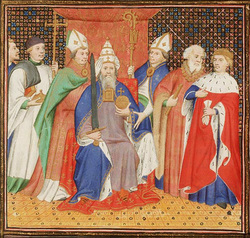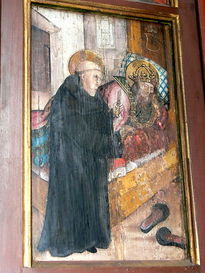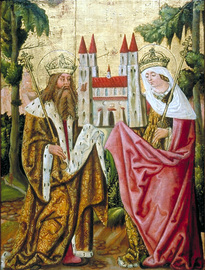


| ArchbishopLefebvre.com |
|
 Henry II, surnamed the Pious, became successively Duke of Bavaria, King of Germany, and the Emperor of the Romans. His hope soared beyond the short enjoyment of a fleeting kingdom, and he aimed at the possession of an unfading crown by living as the loyal servant of the Eternal King. After he became Emperor, he earnestly set himself to the furtherance of the cause of godliness. He restored with new splendour the Churches which had been ruined by the unbelievers, and enriched them with many offerings and possessions. Monasteries and other godly places he either built himself, or endowed them with allowances. He founded out of his own family inheritance the Bishoprick of Bamberg, and made it tributary to Blessed Peter and to the Bishop of Rome. When Benedict VIII, who had set on his head the Imperial crown, was an exile, he hospitably received him, and afterwards restored him to his See.  When he was struck down with a grievous sickness in the Monastery of Monte Cassino, he was healed by an evident miracle through the intercession of St. Benedict. He was princely benefactor to the Church of Rome, for the defence of which he entered into a war against the Greeks, and took again from them the province of Apulia, which they had long possessed. He never undertook anything until he had made it a subject of prayer. And in battle he once saw the Angel of the Lord and the Holy Martyrs his patrons under whose protection he had placed his army, fighting for him in front of his line. With the help of God, he prevailed against the tribes of savages more by prayer than by arms. He gave his sister in marriage to King Stephen of Hungary, whom he induced to be baptized, and so brought all that country to believe in Christ. His marriage with the holy maiden Cunegunda is one of the rare instances of the union of two virgins. When he drew near to death, he gave her back inviolate to her kinsfolk.  He managed with great wisdom whatever could tend to the honour and usefulness of the Empire. He left in France, Italy, and Germany, splendid monuments of his godly munificence. The perfume of his saintly life spread its sweetness far and wide, and the glory of his holiness outshone the splendour of his crown. When the work of his life was done, he was called by the Lord to the possession of an eternal kingdom in the year of salvation 1024. His body was buried in the Church of the Blessed Apostles Peter and Paul at Bamberg, and God glorified him by the miracles which began forthwith to take place at his grave. The same being duly proved, Eugene III numbered him among the Saints. Comments are closed.
|
Archives
December 2014
Categories
All
While Archbishop Lefebvre Blog is provided free of charge, there are administrative and technical costs associated with making it available to subscribers worldwide and with operating this site. Contributions to offset these costs are appreciated, and may be made via the button below
|